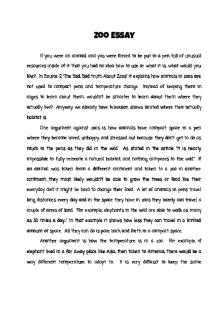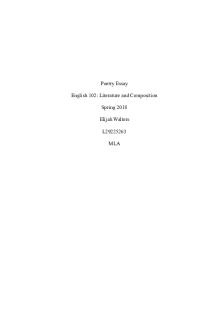Mod B TS Eliot essay - Grade: A PDF

| Title | Mod B TS Eliot essay - Grade: A |
|---|---|
| Course | economics |
| Institution | Carlingford High School |
| Pages | 2 |
| File Size | 67.7 KB |
| File Type | |
| Total Downloads | 72 |
| Total Views | 133 |
Summary
Generic Essay adaptable...
Description
Module B TS Eliot’s suite of poetry portrays a disintegrating society as a result of an existential crisis and its impact in a modernist world of decay, both spiritual and physical. Following the path of Eliot’s personal, spiritual journey, the poetic assembly explores traditional metaphysical ideas and universal notions of humanity. Ideological and religious influences have served as a fundamental impetus for Eliot’s poetic oeuvre however literary critics, such as poet George Bush claim that these influences have ‘’been a progressive downward revision of his once towering reputation’’, declaring a decline in Eliot’s prestige. Consecutively, EXPLICITLY ANSWER QUESTION HERE through alienation and isolation, an internally damaged psyche and lack of purpose. The Love Song of J. Alfred Prufrock (1910) (hereafter, TLSJAP) is a metaphorical introduction into the conscious journey of Eliot’s personal life explored through a poignant sense of alienation and isolation. The persona, Prufrock is speculated to be a fictional dramatis personae mirroring the mind of Eliot’s himself. The epigraph from ‘’Dante’s Inferno’’, alludes to a territory of hell and immediately insinuates that the lexical chain was placed to accommodate for Prufrock’s lack of imagination and his paradoxical inability to claim originality over his authentic thoughts. Additionally, the sky is anthropomorphised through the simile; ‘’like a patient etherized upon a table’’ using modernist technique, minimalism to allow for the interpretation of the surgery as a dissection of the physical body or rather the metaphysical mind. The medical imagery also illustrates the urbanisation and industrial development of the otherwise, decaying, modern world, representing a likely psychosomatic paralysis of the persona. Moreover, Eliot effectively portrays an image of environmental dishevelment and its consequential impact on society to emphasise the persona’s desolated subconscious. The culmination of Eliot’s spiritual journey is examined at a cadaverous lens to explore the untimely demise of the world and his internally damaged psyche. The double entendre apparent in ‘’temperate valley...three trees’’ to metaphorically describe the setting portrays the instability of a spiritually devoid world. This is insinuated through the first meaning of ‘’comfort’’, implying a calm and pleasant experience. However, this connotation is then juxtaposed through the second meaning of ‘’challenge’’, biblically alluding to the moment of despair for a difficult, Christian journey in a ‘’valley of the shadow of death’’. The paradoxical relationship formed through the sense of comfort in conjunction with challenge epitomises the inconsistently fluctuating world. Correspondingly, the repetition of ‘’Do I dare’’ in the rhetorical question, ‘’Do I dare disturb the universe’’ (TLSJAP) implies a socioeconomic inferiority of the persona, Prufrock. The time motif is then further iterated in ‘’I have measured out my life with coffee spoons’’ to symbolise the impaired and disarranged quintessence of Prufrock. Furthermore, Eliot’s views of the world is depicted through his sense of hostility and malevolence towards himself that are projected back to humanity.
Eliot explores the notions of the logical progression of existence and its lack of purpose in a paralysed world through tendencies of habitual scepticism. An asyndetic list of pessimism is exhibited in THM (1925), ‘’shape without form, shade without colour, paralysed force, gesture without motion’’ which encompasses oxymorons to form a paradoxical relationship between existence and nihility. Eliot has utilised syntactic parallels to synthesise a rhythmic echo, inferring a mutually concordant agreement in a vacuum of asceticism. Similarly, the paradoxical relationship between existence and nihility is viewed in the form of ‘’birth’’ and ‘’death’’ in the JOTM (1927). Through the repetition of the rhetorical question of ‘’Birth or Death?’’ followed by a further juxtaposition of the two binary opposites in ‘’I had seen birth and death’’, the resurrection of Jesus Christ is biblically alluded to, who was ‘’born to die’’, further enhancing the paradoxical relationship. Overall, Eliot has effectively catalysed the lack of purpose felt by humans entrapped in an ambivalent world riddled with existential crisis and ultimately, an eternal life after death. Eliot’s suite of poetry has effectively portrayed modernist existentialism by exploring experiential and philosophical perspectives and figures marginalised in a society corrupted by industrialised modernity. Enduring value has been added to the poetic array’s textual integrity and canonical status by virtue of Eliot’s pragmatic exploration of universal concepts such as alienation and isolation, damaged psyche and lack of purpose. Furthermore, Eliot’s personal ontological crisis has been inaugurated through his spiritual progression and has heavily influenced the voyage of his journey from TLSJAP to JOTM. To conclude, EXPLICITLY ANSWER QUESTION HERE....
Similar Free PDFs

Mod B TS Eliot essay - Grade: A
- 2 Pages

TS Eliot - The Hollow Men Notes
- 1 Pages

Rogerian Essay - Grade: B
- 2 Pages

Zoo Essay - Grade: B+
- 2 Pages

Causation Essay - Grade: B
- 4 Pages

Final Essay - Grade: B+
- 12 Pages

Propaganda Essay - Grade: b
- 4 Pages

Poetry Essay - Grade: B
- 5 Pages

Galileo Essay - Grade: B+
- 6 Pages

Fiction Essay - Grade: B
- 7 Pages

EPQ Essay - Grade: B+
- 10 Pages

Law essay - Grade: B
- 9 Pages

Persuasive Essay - Grade: B
- 3 Pages

Evicted Essay - Grade: B+
- 3 Pages

Charities essay - Grade: B+
- 13 Pages
Popular Institutions
- Tinajero National High School - Annex
- Politeknik Caltex Riau
- Yokohama City University
- SGT University
- University of Al-Qadisiyah
- Divine Word College of Vigan
- Techniek College Rotterdam
- Universidade de Santiago
- Universiti Teknologi MARA Cawangan Johor Kampus Pasir Gudang
- Poltekkes Kemenkes Yogyakarta
- Baguio City National High School
- Colegio san marcos
- preparatoria uno
- Centro de Bachillerato Tecnológico Industrial y de Servicios No. 107
- Dalian Maritime University
- Quang Trung Secondary School
- Colegio Tecnológico en Informática
- Corporación Regional de Educación Superior
- Grupo CEDVA
- Dar Al Uloom University
- Centro de Estudios Preuniversitarios de la Universidad Nacional de Ingeniería
- 上智大学
- Aakash International School, Nuna Majara
- San Felipe Neri Catholic School
- Kang Chiao International School - New Taipei City
- Misamis Occidental National High School
- Institución Educativa Escuela Normal Juan Ladrilleros
- Kolehiyo ng Pantukan
- Batanes State College
- Instituto Continental
- Sekolah Menengah Kejuruan Kesehatan Kaltara (Tarakan)
- Colegio de La Inmaculada Concepcion - Cebu
